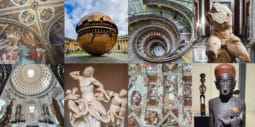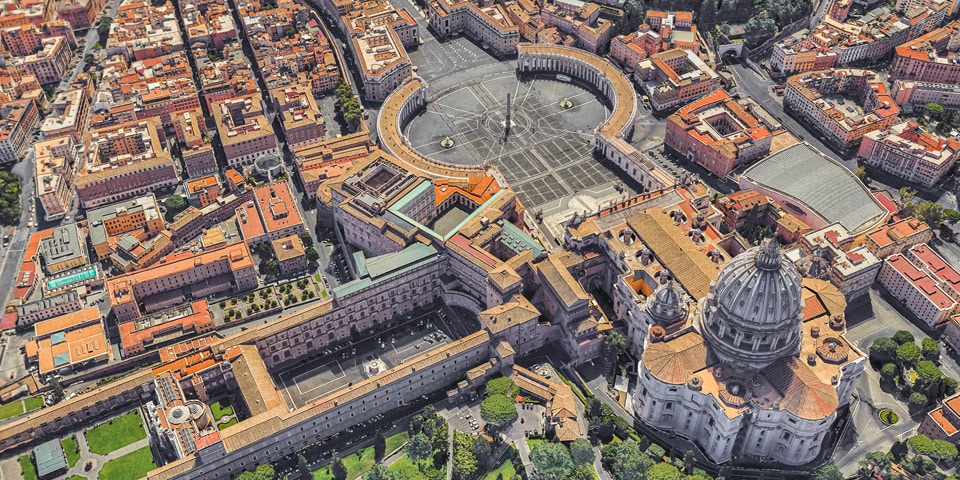

989368 travellers read
Written by: Kate Zusmann

| Tip | Arrive at the square by 6:20 am to enjoy unique views without the crowds of tourists. |
|---|---|
| Opening hours |
Sunday:
-
Monday:
-
Tuesday:
-
Wednesday:
-
Thursday:
-
Friday:
-
Saturday:
-
|
| Recommended tour | |
| Closest bus stops |
|
| Closest subway stations | |
| Address | Piazza San Pietro, Città del Vaticano |
| Website | www.vaticanstate.va |
St Peter’s Square (Piazza San Pietro) in the Vatican City State is one of the most famous squares in the world, accommodating over 300,000 people. It was designed by Gian Lorenzo Bernini and measures 320 metres in length and 240 metres in width. The square is named after Saint Peter, an apostle of Jesus and the first Catholic Pope.
Contents
ToggleThe construction of the square took place between 1656 and 1667 under the direction of the renowned sculptor and architect Bernini, commissioned by Pope Alexander VII. Immediately after the Pope’s election, plans for the square were drawn up and work began, following Alexander’s detailed instructions.
The piazza has a trapezoidal shape, creating a dramatic perspective for anyone exiting the basilica. According to the Lateran Treaty (1929), the area of Saint Peter’s Square falls under the jurisdiction of the Italian police for visitor control, though it remains part of the Vatican City State.
In 1817, circular stones were placed to mark the top of the obelisk’s shadow at noon as the sun entered each sign of the zodiac. This makes the obelisk the gnomon of a giant sundial.
Saint Peter’s Square is flanked on two sides by semi-circular colonnades. According to Bernini, these represent the embracing arms of the Church reaching out to the world. To the left and right of the obelisk are circular marble plates marking the foci of the elliptical square. Interestingly, when standing on either of these plates and looking at the colonnade, it appears as though there is only one row of columns instead of four. This clever optical illusion is a testament to Bernini’s artistic genius and mastery of geometry.
Roughly 400,000 people gather in the square on major occasions such as a Papal election or Easter celebrations.
The square’s focal point is, of course, St Peter’s Basilica, with its magnificent dome. Long queues are common as thousands of people visit daily to admire the square and the grandest church in Christendom, built between 1506 and 1626, which stands to the west of the piazza. You may also spot members of the Pontifical Swiss Guard during your visit to the world’s smallest independent state—and if you’re staying in Rome for more than 2–3 days, you might even request a ticket for a Papal Mass.
The square is vast, and there are many details well worth noticing.
In the centre of Saint Peter’s Square stands the obelisk, 25.5 metres tall—or 41 metres including the pedestal. It was transported to Rome from Heliopolis in Egypt in 1586 and has a fascinating history. The obelisk was originally erected for Cornelius Gallus, the prefect of the city. In AD 37, Emperor Caligula ordered it to be brought to Rome using a specially constructed ship. It was installed on the spine of the Circus of Caligula, which later became known as the Circus of Nero, located on the site now occupied by the Vatican City State.
In 1585, Pope Sixtus V ordered the obelisk to be moved to its current location, approximately 300 metres from its original site. The relocation was an enormous undertaking—even Michelangelo doubted it was possible. Nevertheless, the Pope entrusted the task to Domenico Fontana. It took 900 workers and over 100 horses to complete the move.
Due to the crowds gathered to witness the extraordinary feat, the Pope forbade anyone from speaking during the operation. But as the ropes began to overheat and were at risk of snapping, one sailor shouted in defiance of the order: “Water on the ropes!” His quick thinking saved the operation and possibly many lives. Rather than punish him, Sixtus V thanked and rewarded him. The sailor requested that his family’s farm in Bordighera supply the palms for Palm Sunday each year—a tradition that continues today.
Even now, the Vatican sources its Palm Sunday fronds from Bordighera.
One of the first features to catch the eye is the majestic colonnade, arranged in four rows. There are 284 columns and 88 pilasters that flank the square. The Doric columns measure 20 metres in height and 1.6 metres in width. Above them stand 140 statues of saints, created in 1670 by Bernini and his students. These depict popes, martyrs, evangelists, and other significant religious figures.
There are two fountains in the square—one by Gian Lorenzo Bernini (1677) and another by Carlo Maderno (1613). To maintain symmetry with Maderno’s original design, Bernini created a matching fountain on the opposite side. The final construction was carried out by Carlo Fontana based on Bernini’s plans.
Masses with the Pope are celebrated in St Peter’s Basilica, Saint Peter’s Square, or both. Most services are held within the Basilica, which can accommodate over 15,000 people.
The Holy See issues different types of tickets for Cardinals, Governors and Diplomats, Bishops, Priests, special guests, and the general public. Most Masses require a ticket, which can be obtained free of charge directly from the Swiss Guards at the “Bronze Door” in St Peter’s Square, between 08:00 and 20:00 in summer, and 08:00 and 19:00 in winter.
Leading to the Vatican is the Via della Conciliazione, one of Rome’s most scenic streets, which begins at Castel Sant’Angelo.
What’s your opinion of the Vatican? 🙂
Author: Kate Zusmann
This website uses cookies. For more info read the cookies policy
RomeItaly.guide © 2025. Created with love by Roman experts and guides.